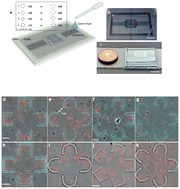A microfluidic method for passive trapping of sperms in microstructures†
Abstract
Sperm motility is a prerequisite for male fertility. Enhancing the concentration of motile sperms in assisted reproductive technologies – for human and animal reproduction – is typically achieved through aggressive methods such as centrifugation. Here, we propose a passive technique for the amplification of motile sperm concentration, with no externally imposed forces or flows. The technique is based on the disparity between probability rates, for motile cells, of entering and escaping from complex structures. The effectiveness of the technique is demonstrated in microfluidic experiments with microstructured devices, comparing the trapping power in different geometries. In these micro-traps, we observe an enhancement of cells' concentration close to 10, with a contrast between motile and non-motile cells increased by a similar factor. Simulations of suitable interacting model sperms in realistic geometries reproduce quantitatively the experimental results, extend the range of observations and highlight the components that are key to the optimal trap design.



 Please wait while we load your content...
Please wait while we load your content...